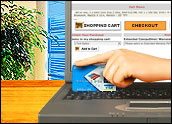
Gone are the days of promotions strategies that begin and end with heavy discounting. Today’s savvy retailers know their promotions strategies must be innovative, creative and customizable to specific consumer segments. Since the online channel often contains the most comprehensive set of retail products, it makes sense for retailers to use the Web as the channel of choice for overall promotions management.
When building a comprehensive online promotions strategy it is important to create offers targeted at acquiring new customers, increasing average order size, moving excess inventory and satisfying customers to build strong loyalty. Without a well-thought-out strategy, and the tools to measure success, it is impossible to know whether or not the promotions are generating true return on investment.
Centralize to Strategize
To get a true measure of promotions success, retailers must centralize the management process. This could result in an organizational shift that empowers the online merchandisers and marketers with more control over promotions strategy.
Further, retailers must be sure the e-commerce system/service provider they choose to run their promotions program allows both the merchandisers to set up catalog and price-based promotions and marketers to run customer acquisition-based promotions. Once this is in place, the company can be on its way to improving margins, increasing sales and creating more loyal customers.
Five Steps of Successful Promotions
Using today’s available tools and technology, multichannel retailers can create customized promotions plans that deliver offers to consumers based on the segmentation of their preferences and shopping behavior. One retailer who has embraced a new promotions strategy and reaped the benefits is Gardener’s Supply.
The multichannel gardening supply retailer had its best year for revenue and profits in 2006 due to its fortified promotions efforts. Promotion-based search results delivered better conversion rates, more than two dozen types of promotions increased customer satisfaction, and promotions overlap created increased conversion rates.
To execute a winning promotions strategy, retailers should follow these five essential steps:
ol.thisol { font-weight:bold }ol.thisol span {font-weight:normal }
- Customer segmentation. The first step of successful promotions execution is to segment customers into groups, particularly when a brand attracts a diverse group of shoppers. By collecting customer data, merchandisers can better understand the triggers that make a consumer react to a specific type of promotion. Tracking consumers by these behavior groups allows retailers to introduce specialized promotional programs and communicate to consumers with relevant offers.
Online capabilities facilitate the collection of information provided by consumers when they register on a site and by their shopping habits. Consumers can then be grouped by price sensitivity, product class, order size, number of visits and other relevant characteristics.
- Get creative with promotions. The goal of promotions is to cut through the noise created by the market, and ultimately get a consumer to make purchase. For this reason, promotions must be creative and offer real value. Think beyond discounts. New promotional concepts — such as shipping destination, shipping methods, “x” first customers, every “nth” customer, every “x” order, items per promotion, apply offer to “nth” item, returns-based, payment method, free product choice, rebates, multiple bonus products and many others — are starting to be used by some of the most innovative retailers on the Web.
Some retailers are even starting to use stock-level based promotions to move excess inventory. Although there is a lot of flexibility with online promotions, one warning to the wise: Be sure to have rules in place for managing promotions to avoid pitfalls such as giving away double offers or unintentionally not providing a consumer with the best available promotion.
- Test promotions. Once the customers are organized into relevant groups and the promotions have been created, retailers can better determine the effectiveness of certain promotions by performing A/B tests. A/B tests are a comparative form of testing that allow merchants to test several promotion types against a typical offer to determine which option will yield the best results.
For example, different promotions can be offered to a single group of consumers to find out which promotion is more effective. This can be as simple as offering a 20 percent discount versus a 30 percent one to determine discount thresholds. Since it delivers real-time results, A/B testing is the best vehicle for testing time-sensitive offers. Testing is an import measurement tool for protecting against over promotion, which unfortunately leads to reduced margins.
- Use search to deliver relevant promotions. Over the years, consumers have been trained to react to promotions since they convey the sense of value. With more than 70 percent of shopping trips starting with the search key, online browsing is no longer a passive consumer activity. Since customers already share personal information when they hit the search key, retailers should be actively involved in tailoring search responses to deliver relevant promotions as part of the search results.
Many retailers today use search-based promotions to drive cross-selling and up-selling of products in order to increase basket size — such as suggesting coordinating hand bags and jewelry that are discounted when purchased along with a specific dress.
- Build an ongoing promotions strategy for loyalty. Deep discounting across the board used to be the norm in the retail industry. However retailers are getting savvy to the fact that offering deep discounts to all customers is serving only to lower margins and cheapen the value of the products among many customers who would probably have purchased anyway. Armed with more precise promotions technology to track effectiveness, today’s retailing strategies are moving more towards loyalty-based promotions, such as a “surprise and delight” giveaway.
Time has shown that customers appreciate receiving something for free, especially when they are not expecting it. These customers are likely to return to purchase again. Small things can go a long way, such as sending the customer a thank-you message along with a percent-off coupon for their next purchase.
The Future Is Now
To help run a successful Web site and execute online promotions, make sure e-commerce providers offer the most up-to-date solutions available. Some of the latest promotions technology to look for include:
- Promotions rules engine — attaching business rules to promotions to drive incremental sales
- Image-based promotions — attaching images to promotions for greater visual appeal
- Promotions import/export — bringing in/sending out promotions from/to other systems to manage from the system of record
- Promotions reporting — tracking the success rate of promotions for better future decision-making
Moving forward successfully into the future, today’s retailers must vary the types of the promotions they offer, to maintain a high level of consumer satisfaction toward their brand. Success is a simple recipe: Learn about the most loyal shoppers, promote to a targeted audience, keep customers happy and loyal, and sell products.
Of course, remember to be creative. The key is getting consumers to interact with the brand based on their typical shopping practices. Executing effective promotions combines using the best technology with the fine art of truly knowing individual customers.
Stephan Schambach is founder and chairman of Demandware, an on-demand e-commerce platform provider.





































Social Media
See all Social Media